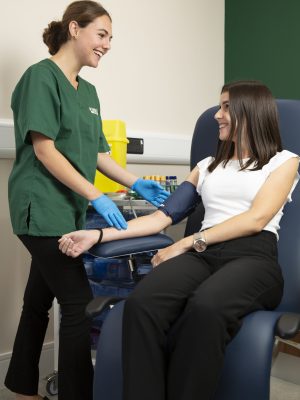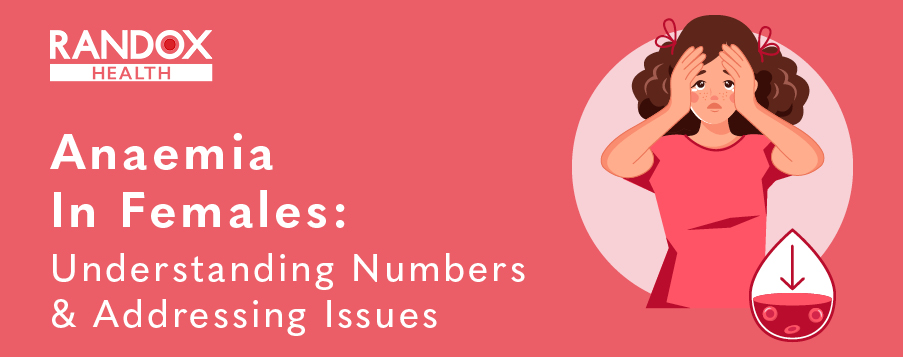22/07/2024
Imagine feeling constantly tired, weak, or even dizzy – these are just a few of the anaemia symptoms that lots of women live with every day due to low haemoglobin or iron levels.
Anaemia and iron deficiency are two widespread health issues that affect many women globally. Recent analysis of data gathered by Randox Health has revealed just how common these conditions are, underscoring the urgent need for greater awareness and proactive management. In this article, we’ll explore the underlying causes, tell-tale signs, and best practices for diagnosing and treating anaemia and iron deficiency.
Anaemia in Females: An Overview
Anaemia and iron deficiency are prevalent issues among females, with significant impacts on overall health and well-being. Understanding the causes, symptoms of anaemia, and treatment options is essential for managing these conditions effectively.
Diagnosis involves several steps. Blood tests are crucial for checking haemoglobin and ferritin levels. A Full Blood Count (FBC) provides a detailed look at the blood components, offering insights into overall health3. Iron studies, which measure different aspects of iron in the body, including iron, ferritin, total iron-binding capacity (TIBC), and transferrin saturation, are also important2. These tests help determine the underlying cause of anaemia and iron deficiency, ensuring accurate diagnosis and treatment.
Anaemia occurs when there are not enough healthy red blood cells or haemoglobin in the blood to carry adequate oxygen to the body’s tissues. Iron is a crucial component of haemoglobin, the protein in red blood cells responsible for carrying oxygen throughout the body. Iron deficiency anaemia, the most common type, often arises from poor nutrition, insufficient dietary iron intake, issues with iron absorption2 or significant blood loss1.
For females, this can be particularly problematic due to factors like menstruation and pregnancy. Recent analysis of data gathered by Randox Health shows that out of 32,233 haemoglobin results, 3,022 were below the National Institute for Health and Care Excellence (NICE) guidelines, representing 9.4% of the female population studied.
Iron Deficiency in Women
Iron deficiency is one of the most common nutritional deficiencies worldwide and a leading cause of anaemia. It occurs when the body lacks enough iron to produce haemoglobin. Without sufficient haemoglobin, tissues and organs don’t get enough oxygen, leading to a range of symptoms and health issues2.
From the data collected by Randox Health, 9,547 out of 32,251 results showed ferritin levels below the NICE guidelines, indicating a 29.6% prevalence rate of iron deficiency among females in this cohort.
Causes of Anaemia and Iron Deficiency In Females
Iron deficiency & anaemia can arise from several factors often overlapping, particularly in females. Primary causes include:
Significant blood loss can deplete iron stores. For females, heavy menstrual periods are a primary cause of blood loss. Gastrointestinal bleeding from ulcers, polyps, cancers, or the regular use of NSAIDs like ibuprofen and aspirin can also lead to significant iron loss. Surgeries or injuries that result in blood loss further contribute to this issue3.
Not consuming enough iron-rich foods is a major cause of iron deficiency. Foods high in iron include red meat, poultry, fish, beans, lentils, spinach, and iron-fortified cereals3.
Certain medical conditions can impair the body’s ability to absorb iron. These include Coeliac Disease, Crohn’s disease, ulcerative colitis, and H pylori infection. Surgeries involving the stomach or intestines, such as gastric bypass surgery, can also reduce iron absorption, making it difficult for the body to maintain adequate iron levels3.
Pregnancy significantly increases the body’s demand for iron due to the increased blood volume and the needs of the growing baby. Rapid growth periods in children and adolescents also elevate the demand for iron. If dietary intake does not meet this increased need, iron deficiency can develop3.
Chronic illnesses, such as inflammatory bowel diseases and other conditions that cause chronic inflammation, can interfere with iron absorption and utilisation. This can exacerbate iron deficiency and lead to anaemia over time3.
In summary, the interplay between nutrition, blood loss, absorption issues, increased physiological demands, and chronic conditions contributes to the high prevalence of iron deficiency and anaemia in females. Addressing these factors through diet, medical treatment, and lifestyle adjustments is crucial for managing anaemia symptoms and complications.
Anaemia Symptoms In Females.
The symptoms of anaemia and iron deficiency often overlap and can include3:
Fatigue & weakness
Shortness of breath
Pale or yellowish skin
Diziness/Light-headedness
Cold hands & feet
Brittle Nails
Diagnosis: Identifying the Issue
NICE Guidelines for Anaemia and Iron Deficiency
NICE provides guidelines to help diagnose and manage anaemia and iron deficiency. These guidelines recommend regular screening for at-risk groups and outline the appropriate levels of haemoglobin and ferritin to look for in blood tests:4,5
- Regular screening is recommended for populations at risk, including pregnant women and individuals with gastrointestinal conditions or chronic diseases.
- Blood tests such as FBC, serum ferritin, serum iron, TIBC, and transferrin saturation are essential for diagnosis.
- For non-pregnant women over 15 years, anaemia is defined as a haemoglobin level below 120 g/L. For men over 15 years, it is below 130 g/L5.
- Ferritin levels below 30 µg/L typically indicate iron deficiency, but higher thresholds may apply in the presence of inflammation5.
- Treatment often involves oral iron supplements like ferrous sulphate, ferrous fumarate, or ferrous gluconate for about three months3.
- Intravenous iron may be considered if oral supplements are ineffective or not tolerated3.
- Identifying and treating the underlying cause of iron deficiency is crucial to prevent recurrence3.
- Medical Treatments: In severe cases, treatments like iron infusions or blood transfusions might be required6.
Prevention Strategies
Preventing these conditions involves adopting a balanced diet rich in iron3. Regular check-ups are crucial, especially for those with heavy menstrual cycles or chronic illnesses1. Awareness is another key aspect; understanding the signs and symptoms of anaemia and iron deficiency can lead to early intervention and better management. Public health initiatives and educational programs can also play a significant role in prevention efforts, spreading knowledge about the importance of maintaining healthy iron levels3.
How Randox help prevent Anaemia in Females.
Randox Health offers comprehensive health checks that include testing for several biomarkers related to anaemia and iron deficiency. Here are the key biomarkers we test for:
- Haemoglobin Levels: This is crucial for diagnosing anaemia, as low haemoglobin levels indicate a reduced capacity of red blood cells to carry oxygen.
- Ferritin Levels: Ferritin is a protein that stores iron, and low levels can indicate iron deficiency.
- Iron Levels: Measuring serum iron helps determine the amount of iron circulating in the blood.
- Total Iron-Binding Capacity (TIBC): This test measures the blood’s capacity to bind iron with transferrin, a protein that transports iron.
- Transferrin Saturation: This indicates the percentage of transferrin that is saturated with iron, helping to diagnose iron deficiency and understand iron metabolism.
These biomarkers are part of our comprehensive Everyman and Everywoman packages, which are designed to provide detailed insights into your overall health, including nutritional status and potential deficiencies.
Everywoman Health Check
Specifically tailored for women, the Everywoman test provides a comprehensive overview of health markers crucial for female wellness. This test covers up to 150 data points related to key health areas including a full blood count, heart health, diabetes health and much more. The Everywoman test also analyses thyroid function and reproductive hormones, like oestrogen and progesterone, which can impact menstrual cycles and influence menopausal transitions.
With your Everywoman test, you’ll receive a 12-month plan, including 2 health checks, allowing you to monitor how any lifestyle changes you make affect your health. You can also choose to book a health and well-being discussion with a member of our highly trained team, or an appointment with one of our GPs, ensuring you fully understand all the information and data you get with your results report.

Frequently Asked Questions:
What is the main cause of anaemia in females?
The primary cause is often heavy menstrual bleeding, which leads to significant blood loss.
How can I increase my iron levels naturally?
Consume more iron-rich foods such as lean meats, beans, and fortified cereals. Pairing these with vitamin C-rich foods can also enhance iron absorption.
Are iron supplements safe?
Iron supplements are generally safe when taken as directed, but it’s important to consult with a healthcare provider to avoid potential side effects like constipation or stomach upset.
How often should I get my iron levels checked?
For women with risk factors like heavy periods or chronic illnesses, regular screenings every six months to a year are advisable.
Can anaemia affect pregnancy?
Yes, anaemia can lead to complications such as preterm delivery and low birth weight, making it crucial to monitor and manage iron levels during pregnancy.
Is fatigue always a symptom of anaemia?
Not necessarily. While fatigue is a common anaemia symptom, it can also result from other conditions. It’s important to get a proper diagnosis from a healthcare provider.
Conclusions
Anaemia and iron deficiency are prevalent issues among females, with significant impacts on overall health and well-being. Understanding the causes, symptoms of anemia, and treatment options is essential for managing these conditions effectively. By following NICE guidelines and incorporating healthy dietary practices, women can better manage and prevent these health challenges.
References
- World Health Organisation. Anaemia. https://www.who.int/health-topics/anaemia.
- Cleveland Clinic. Iron-Deficiency Anemia. https://my.clevelandclinic.org/health/diseases/22824-iron-deficiency-anemia.
- NHS. Iron deficiency anaemia. https://www.nhs.uk/conditions/iron-deficiency-anaemia/.
- National Institute of Health and Care Excellence. Scenario: Management of iron deficiency anaemia. https://cks.nice.org.uk/topics/anaemia-iron-deficiency/management/management/.
- National Institute for Health and Care Excellence. What investigations should I arrange to confirm iron deficiency anaemia? https://cks.nice.org.uk/topics/anaemia-iron-deficiency/diagnosis/investigations/.
- National Heart L and BI. Iron-Deficiency Anemia. https://nhlbi.nih.gov/health/anemia/iron-deficiency-anemia.



